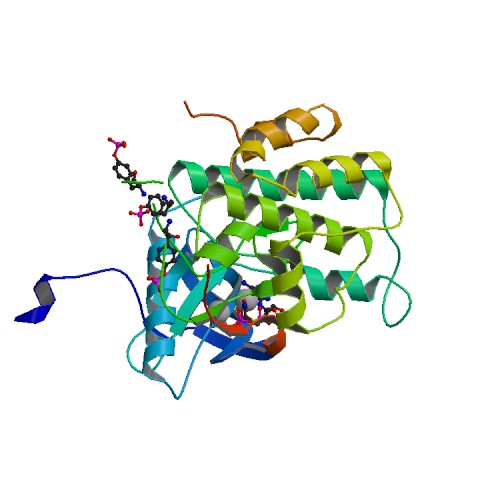Pineal Hyperplasia, Insulin-Resistant Diabetes Mellitus, And Somatic Abnormalities

A number sign (#) is used with this entry because of evidence that the Rabson-Mendenhall syndrome is caused by compound heterozygous mutation in the insulin receptor gene (INSR; 147670) on chromosome 19p13.
Clinical FeaturesRabson and Mendenhall (1956) described 3 sibs (2 girls, 1 boy) who initially presented with dental and skin abnormalities, abdominal distention, and phallic enlargement. The children demonstrated early dentition, a coarse, senile-appearing facies, and striking hirsutism. An 'adult growth of hair of head' at 5 years of age was pictured in the case of one of the girls. In the older girl the genitalia were large enough at the age of 6 months to permit vaginal examination for diagnosis of a left ovarian tumor which was removed soon afterward. The children were mentally precocious. Prognathism and very thick fingernails as well as acanthosis nigricans were also described. Insulin-resistant diabetes developed, and the patients died during childhood of ketoacidosis and intercurrent infections. At necropsy pineal hyperplasia was found in all 3. Rabson and Mendenhall (1956) stated that 'the histories...gain in value because the family physician (E.N.M.) brought them and their siblings into the world, and cared for them until they died...' Cases probably of the same condition in 2 sisters, offspring of first-cousin parents, were described by Barnes et al. (1974). They did not have abnormality of the teeth and nails and were living at ages 23 and 11 years, when reported. (Accili et al. (1989) demonstrated that these 2 sisters had a point mutation of the insulin receptor gene (147670.0011).) West et al. (1975) described brother and sister with the syndrome. They showed unusual facies, dry skin, acanthosis nigricans, thickened nails, hirsutism, dental precocity and dysplasia, abdominal protuberance, and phallic enlargement. Both had diabetic ketoacidosis with insulin resistance. The elder, a girl, had recurrent sepsis and died at the age of 7.8 years. The pineal body was hyperplastic at autopsy. West and Leonard (1980) gave follow-up information on the surviving brother, aged 12 years. Monocyte-binding studies suggested that the condition is a genetic deficiency of insulin receptors.
Biochemical FeaturesIn a 6-year-old boy with clinical features of Rabson-Mendenhall syndrome, Takata et al. (1986) found decreased insulin binding in erythrocytes, cultured fibroblasts, and transformed lymphocytes. This was taken as an indication of a primary defect in insulin receptors. In a patient with the Rabson-Mendenhall syndrome, Moncada et al. (1986) found a 90% decrease in the number of insulin receptors. Since previous studies had shown that the marked decrease is not due to accelerated receptor degradation, they investigated the possibility that reduced synthesis might be responsible. Their experiments suggested that the receptor precursor is synthesized at a normal rate and that once the receptor is inserted into the membrane, it is degraded at a normal rate. Therefore they proposed that there may be a defect between synthesis and insertion into the membrane. Taylor et al. (1983) found residual insulin binding by cultured fibroblasts even though cultured lymphocytes showed markedly reduced insulin binding. It appeared that the residual binding in the case of fibroblasts had a different affinity of insulin binding. Taylor et al. (1983) suggested that the low level of residual binding might involve primarily receptors for insulin-like growth factors rather than insulin itself.
Rittey et al. (1988) documented elevated melatonin metabolite excretion in the urine of a patient with Mendenhall syndrome presenting with neonatal hypoglycemia. The secretion of melatonin from the pineal gland is linked to the light-dark cycle, being greater at night in all species, including humans, and it is pulsatile (de Leiva et al., 1990; Lewy et al., 1980). Some patients with hypothalamic hypogonadism have unusually high plasma melatonin concentrations, suggesting that increased pineal activity may be involved in the pathogenesis of this condition (Puig-Domingo et al., 1992).
Clinical ManagementCochran et al. (2004) reported that treatment of 2 sibs with Rabson-Mendenhall syndrome with pharmacologic doses of human leptin (164160) resulted in improvement of fasting hyperglycemia, hyperinsulinemia, basal glucose, and glucose and insulin tolerance.
Molecular GeneticsIn a patient with Rabson-Mendenhall syndrome described by Moncada et al. (1986), Kadowaki et al. (1990) identified compound heterozygosity for mutations in the INSR gene (147670.0012-147670.0013).
In an English patient with Rabson-Mendenhall syndrome, Takahashi et al. (1998) identified compound heterozygosity for mutations in the INSR gene (147670.0034-147670.0035).